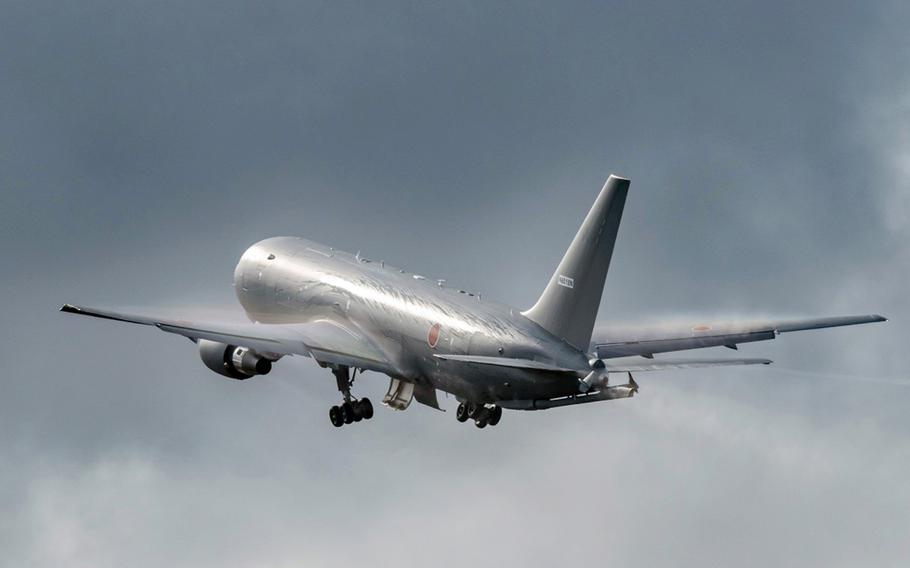
The first of four KC-46A Pegasus aerial refuelers arrives at Miho Air Base, Japan, Friday, Oct. 29, 2021. (Boeing)
The most important task for in-flight refueling tankers is to be close to the fight.
The location where tankers and receiver aircraft meet is called the “anchor,” and that’s exactly what tankers are — the anchor of aerial missions. The mission of air-to-air refueling tankers is to minimize the fuel burned by the attack aircraft when they leave their nearby tanker and return to attack their targets. Those attack aircraft must have adequate fuel to return to their post-mission tanker to top-off before recovering at its base of operations. Tactical fighters or strategic bombers may also have a mission requirement to attack targets that are not close together, making fuel management paramount. The location and capacity of tankers are critical and necessary for success.
The venerable KC-135 fleet had such capabilities for theater operations. The next logical fleet improvement is the KC-46, with its increased fuel off-load capacity and significant improvements in mission capability enabled by its larger cargo deck area and volume. The increased deck area enables loading of significantly larger and enhanced medevac equipment and the number and variety of patients that could be flown out of harm’s way. This multi-role mission capability allows for a refueling mission that could be followed separately by delivering cargo to bases in need before returning to home base.
It’s common that tactical fighters have multiple, non-collocated targets on a single mission. Having tankers close to the fight reduces the gross mission fuel burn, enabling the sum of the fighters’ and tankers’ fuel consumption to last longer for complex missions. While larger tankers have more fuel storage capacity, they come at a cost that could lead to the procurement of fewer tankers. Fewer tankers means more planes will be clustered around a single tanker, decreasing mission capability and increasing the risk to tactical fighters.
Based on the tried and true 767, the KC-46’s ground footprint and taxiing agility is compatible at most military and commercial airports. Reversely, a larger tanker would obligate many airports, which otherwise accept 767s, to make capital improvements. Additionally, the American supply chain for the 767 is well established and already operating.
Procurement of a larger tanker would also require the additional expense to manage the administrative process itself. That unique cost, when divided by the likely fewer planes, would result in a higher cost per plane. While some argue that a larger tanker is better able to support trans-oceanic deployment of entire combat wings and squadrons, such logic is insufficient to justify the purchase of a small number of tankers that lack the flexibility needed to complete missions while in a combat arena. Those dollars would be better spent on increasing the number of KC-46 in the U.S. Air Force fleet, which support both trans-oceanic deployments and combat theater operations.
The 767 as a base is stable commercially, and is available as a proven derivative military aircraft. Additionally, progressive technical upgrades will be available for both the commercial and military customer to ensure next-generation capabilities. These additions are an inherent attribute of maintaining a product family for the long run that also reduces the life-cycle cost of any single plane.
Envision a KC-46 Pegasus capable of refueling multiple receivers simultaneously by employing both conventional refueling booms and retractable probe and drogue equipment. The training of both the tanker and receiver crews will take place as new capabilities arrive, for retrofit or andon production.
The current 2022 National Defense Authorization Act that soon will be considered before the Senate includes funding for 14 KC-46A tanker aircraft — an important step toward supporting the future of this program. On cost, capability and readiness, the KC-46 is simply the best tanker to ensure our Air Force can remain close to the fight, as well as win it.
Brian DeLuca is retired from a career spanning 46 years in aerospace, science and technology. As a U.S. Air Force pilot, his primary planes were the McDonnell RF4C Reconnaissance Phantom and the Lockheed C-141A. As an RF4C refueling receiver, he has over 200 hook-ups in combat with the KC-135.